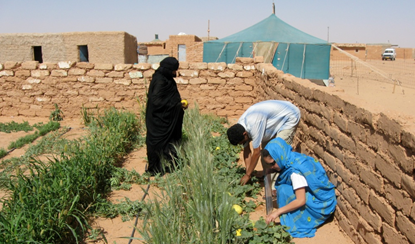Making the Sahara Bloom

In March 2007, when I gave a fig sapling to a friend from USA, we transplanted it in the Salam English School yard, where she was teaching in the Sahrawi refugee camps near Tindouf, Algeria. We then talked about the problems of malnutrition here in the camps due to the lack of vitamins and minerals in the food basket that the World Food Programme has distributed to the refugees, whose country came under occupation 40 years ago. One foreseeable solution, I proposed, was to help the refugees produce part of their nutritional needs in their own gardens.
Here in the Smara Refugee Camp, formerly pastoralist inhabitants need training in agricultural practices, materials for watering the plants and protecting fruits under their harsh climatic conditions. These needs invoked the dream of starting a home gardens project here in the camps, in which people would be able to produce part of their need for vegetables and fruits.
One year later, my friend came to my house and told me that her NGO, Not Forgotten International, Inc. (NFI) was interested in starting a home-garden project here in the camps.
After producing a study and plan for such a project, in late 2008 I then hosted an American family who brought some seeds and some money for creating home gardens in the camps.
In August 2009, an American engineer arrived to the camps just a few days before Ramadan. I still remember him suffering a lot from the heat and from fasting during Ramadan in solidarity with his new Saharawi host family. Immediately after iftar,we started discussing plans with the governor of Ausserd, the project’s target refugee camp. We eventually decided to start with 30 gardens, five in each of the camp’s six diaras (districts).
The many daunting challenges included harsh climate, the shortage and bad quality of water, sandy eroded soil with no organic matter and the families’ disbelief that they could raise gardens by themselves.
The plan called for a 100m2 home garden for each home, divided into two parts. The first one was a 6x4m green house for planting tomatoes, bell and hot peppers, lettuce, eggplant and zucchini. The second one was dedicated to crops that do not need a controlled environment and could grow during the cold season: carrots, turnips, beets, onions, peas, fava beans, cilantro, parsley, mint and chard. Wind breakers, consisting mainly of Moringa trees and three fruit trees, protected the gardens. We also installed a drip-irrigation network connected to a 1m3 water container a 1m-high platform.
We found that we could set up one-to-two gardens a day. The visiting volunteer trained the project coordinator and families on how to conduct the periodic maintenance needed on the irrigation network. Later we trained the families on how to prepare the soil for the coming season.
By late January 2010, we started sowing various melon seeds. As we didn’t have wind breakers at that time, we planted rows of millet between the melons to protect them from the common sand storms. During the first season, the families received some basic practical training on agricultural practices for tending their gardens. We also completed the installation of the drip irrigation for 30 additional family gardens.
In late in May and early June 2010, the 30 families were able to reap the first fruits of their labor. It made me very happy to witness their joy at the results. Those were the most delicious melons I have ever tasted!
In April 2010, we designed a 6x4m greenhouse and asked a local workshop to produce 60 metal frameworks for us. In September, friends from abroad came with a lot of seeds, and we started our first real project now with 60 gardens, at the same time we started constructing the greenhouses. Later in December, we were able to transplant tomatoes, lettuces, bell peppers and eggplant seedlings in those greenhouses.
Continuing the practical training for the families, we chose one person from every diara to be its coordinator. Those coordinators received more training, in order then to convey more knowledge to the project beneficiaries.
Over six years, the families received much training, concentrated mainly on:
- Agricultural practices.
- Methods of organic agriculture such as composting, mulching, biological control of pests, production of bio fertilizers and preparations to control the pests, weeds, etc.
- Some basics of permaculture.
- Production of seeds.
A new NFI volunteer came to the camps in 2013–14 with a special interest in compost toilets and aquaponics. The six coordinators—Fatimato, Aichato, Aminato, Mariam, Joueda and Elghalia—are no longer working on the project due to the limited financial resources. However, we now have a Sahrawi model of home gardens was designed according to an anti evapo-transpiration strategy and the economical use of irrigation water.
In those past five years, we were really impressed by the achievements as most of the families were able to produce more than their needs from certain crops. They either shared the surplus with their neighbours, or sold it in the local market. Many were able to produce some of their seeds by themselves, compost their organic matter and produce some bio fertilizers.
With much gratitude to the NFI volunteers, the project now is hampered by lack of funding. However, the effort has left behind unprecedented results, a cadre of human capital with acquired agricultural skills, new potential and an increasing demand among Sahrawi refugees to meet some food needs independently.
For more information, contact:
Eng. Taleb Brahim
Sahrawi Union of Farmers
Tindouf, Algeria
Email: tbrahim8@gmail.com
See also:
Sahrawi Arab Democratic Republic Launches its CAADP Process (21 December 2014)
اتحاد المزارعين الصحراويين ينوي رفع دعوى لدى محكمة العدل الأوربية بخصوص استيراد دول الاتحاد الأوربي المنتجات الفلاحية الصحراوية (15 January 2014)
Photo: Local camp residents tending home garden. Source: Taleb Brahim.
|